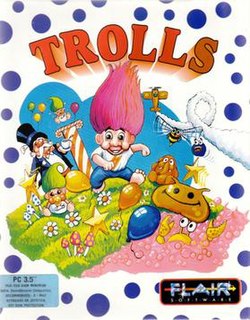
Zool: Ninja of the Nth Dimension is a platform game originally produced for the Amiga by Gremlin Graphics in 1992. It was later ported to several other platforms and followed by Zool 2 in 1993.

Mindscape, Inc. was an American video game developer and publisher based in Novato, California. Founded in March 1983, its most notable titles include Law & Order: Criminal Intent and Lego Island.

Turrican is a 1990 video game programmed and designed by Manfred Trenz. It was developed for the Commodore 64 by Rainbow Arts, and was ported to other systems later. In addition to concept design and character creation, Trenz personally programmed Turrican on the Commodore 64. A sequel, Turrican II: The Final Fight, followed in 1991 for the Commodore 64 and other platforms.

Striker is a soccer video game series first released by Rage Software in 1992.

The Last Ninja is a series of video games published by System 3. The first game in the series, titled The Last Ninja, was released in 1987 for the Commodore 64 and was one of the most successful games for the system. In 1988, System 3 released Last Ninja 2, and in 1991 the third game in the series, Last Ninja 3. In 1990, Last Ninja Remix was released for 8-bit systems. This was Last Ninja 2 with new music, a new introductory sequence, slightly changed graphics and fixed bugs. Confusingly, the 16-bit versions of the original The Last Ninja game were also released in 1990 as Ninja Remix.
Allister Mark Brimble is a British video game music composer. Brimble began composing music and sound effects for the video game industry in the mid-1980s. He also produced various audio tracks, as "Brimble's Beats", that were distributed on cover disks of magazines including CU Amiga and Amiga Format.

There have been several video games based on the 1991 film Hook. A side-scrolling platform game for the Nintendo Entertainment System (NES) and Game Boy was released in the United States in February 1992. Subsequent side-scrolling platform games were released for the Commodore 64 and the Super Nintendo Entertainment System (SNES) later in 1992, followed by versions for the Sega CD, Sega Genesis, and Sega's handheld Game Gear console in 1993. An arcade game was also released in 1993.

RoboCop 3 is a video game based on the 1993 film of the same name. An Amiga version was developed by Digital Image Design beginning in September 1990, and it was published by Ocean Software in December 1991. The Amiga version includes multiple gameplay styles. During 1992 and 1993, other versions consisting of side-scrolling platform gameplay were released for the Atari ST, DOS, Commodore 64, ZX Spectrum, Arcades, NES, SNES, Game Gear, Master System, and Sega Genesis.
David Lowe also known as "Uncle Art" is a British composer known for his work on computer games from 1985 to 1998.

Krisalis Software Limited was a video game developer and publisher founded by Tony Kavanagh, Peter Harrap, and Shaun Hollingworth in 1987 under the name Teque Software Development Limited as a subsidiary label until the official company name was changed to Krisalis Software Ltd. in 1991. Originally, the name was intended to be Chrysalis Software Ltd., but a dispute with record company Chrysalis Records resulted in a minor spelling change. The company was restructured in April 2001 with a new management team of Tony Kavanagh, Tim James and Simeon Pashley and reused the original name of Teque Software development.

Flair Software was a British video game developer and publisher of the 1990s that developed and published games for the Amiga, Amiga CD32, Atari ST, Commodore 64, DOS, PlayStation, Sega Saturn and SNES. The developer is mainly associated with popular and colorful Amiga games as Elvira: The Arcade Game, Trolls, Oscar and Whizz. In 1993 platformer Oscar was bundled with Millennium's Diggers as launch bundle for the Amiga CD32 and it was considered as one of the mascot games for the failed system. Flair Software's 1994 fighting game Dangerous Streets is generally considered as one of the worst games of all time.

Vivid Image was a video game developer from the United Kingdom, founded in 1988 by Mevlut Dinc, Hugh Riley and John Twiddy, all former employees of System 3. Their debut game was Hammerfist for the Amiga, Amstrad CPC, Atari ST, Commodore 64 and ZX Spectrum, released in 1990. Hammerfist is also notable for being one of the few games that was developed for the failed and never released Konix Multisystem game console. Vivid Image also created the development system for the Commodore 64GS, another failed game console, and helped publishers with putting their games on the C64GS cartridges.

Ninja is a flip screen beat 'em up game developed by Sculptured Software and released by Mastertronic in 1986 for the Atari 8-bit family, Commodore 64, and ZX Spectrum, and in 1987 for the Amstrad CPC, Amiga, Atari ST and MS-DOS. An arcade version of the game was released in 1987 for Mastertronic's Arcadia Systems, an arcade machine based on Amiga hardware.

Trolls is a Troll doll-themed platform game developed and published by Flair Software for the Amiga, MS-DOS and Commodore 64 in 1992. In 1994 it was ported to the CD32.




















